JCU LB5235 Applied Research Project: AIS Evolution Report and Analysis
VerifiedAdded on 2022/12/14
|16
|3312
|92
Report
AI Summary
This report examines the evolution of Accounting Information Systems (AIS) and its impact on organizational effectiveness. The research employs a quantitative methodology, utilizing questionnaire surveys with business managers and interviews with accountants. Data analysis techniques, including correlation and regression, are applied to assess the relationship between AIS and task efficiency, with auditing and controlling identified as key independent variables. The study identifies barriers to AIS implementation, such as strategy formulation, environment, and organizational structure. The findings reveal a positive correlation between AIS and organizational effectiveness, suggesting that improvements in AIS can enhance auditing and controlling functions. The report also provides a timeline of the research activities and discusses risk management considerations. The study concludes that AIS is crucial for all types of business organizations and offers significant benefits, including enhanced financial transaction management and improved decision-making processes, while also acknowledging the limitations of AIS such as risk of data loss and the complexity of implementation.
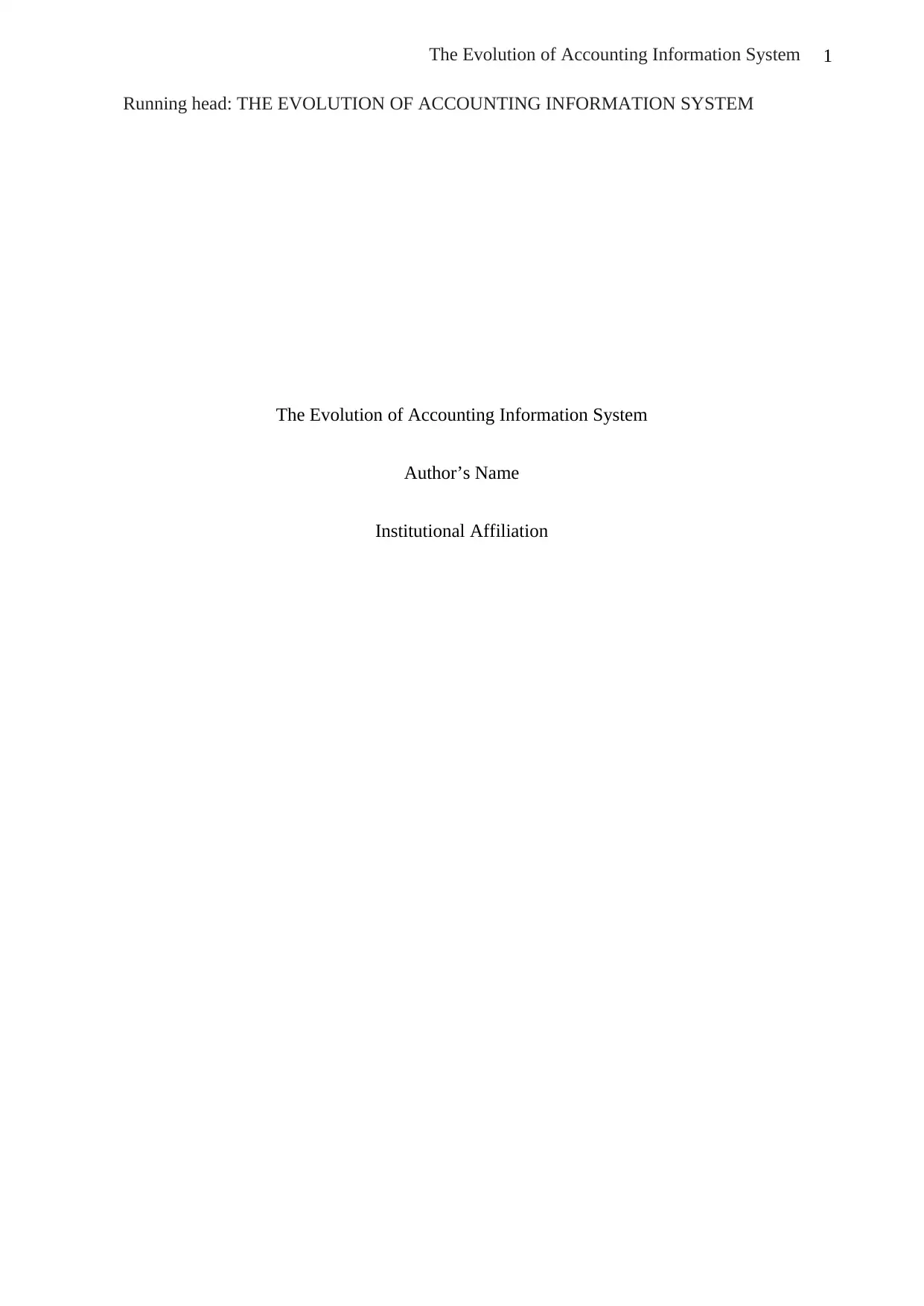
1The Evolution of Accounting Information System
Running head: THE EVOLUTION OF ACCOUNTING INFORMATION SYSTEM
The Evolution of Accounting Information System
Author’s Name
Institutional Affiliation
Running head: THE EVOLUTION OF ACCOUNTING INFORMATION SYSTEM
The Evolution of Accounting Information System
Author’s Name
Institutional Affiliation
Paraphrase This Document
Need a fresh take? Get an instant paraphrase of this document with our AI Paraphraser
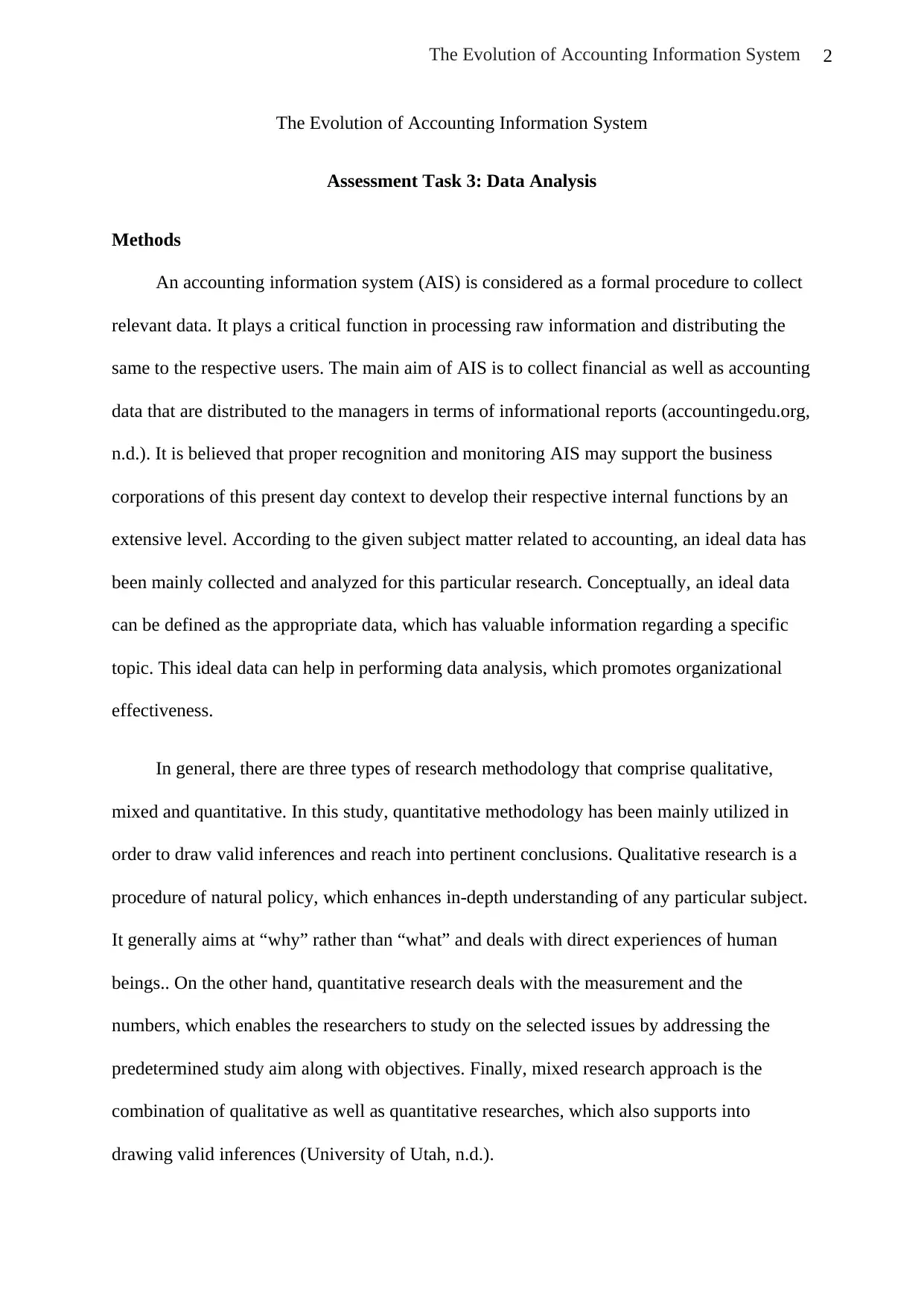
2The Evolution of Accounting Information System
The Evolution of Accounting Information System
Assessment Task 3: Data Analysis
Methods
An accounting information system (AIS) is considered as a formal procedure to collect
relevant data. It plays a critical function in processing raw information and distributing the
same to the respective users. The main aim of AIS is to collect financial as well as accounting
data that are distributed to the managers in terms of informational reports (accountingedu.org,
n.d.). It is believed that proper recognition and monitoring AIS may support the business
corporations of this present day context to develop their respective internal functions by an
extensive level. According to the given subject matter related to accounting, an ideal data has
been mainly collected and analyzed for this particular research. Conceptually, an ideal data
can be defined as the appropriate data, which has valuable information regarding a specific
topic. This ideal data can help in performing data analysis, which promotes organizational
effectiveness.
In general, there are three types of research methodology that comprise qualitative,
mixed and quantitative. In this study, quantitative methodology has been mainly utilized in
order to draw valid inferences and reach into pertinent conclusions. Qualitative research is a
procedure of natural policy, which enhances in-depth understanding of any particular subject.
It generally aims at “why” rather than “what” and deals with direct experiences of human
beings.. On the other hand, quantitative research deals with the measurement and the
numbers, which enables the researchers to study on the selected issues by addressing the
predetermined study aim along with objectives. Finally, mixed research approach is the
combination of qualitative as well as quantitative researches, which also supports into
drawing valid inferences (University of Utah, n.d.).
The Evolution of Accounting Information System
Assessment Task 3: Data Analysis
Methods
An accounting information system (AIS) is considered as a formal procedure to collect
relevant data. It plays a critical function in processing raw information and distributing the
same to the respective users. The main aim of AIS is to collect financial as well as accounting
data that are distributed to the managers in terms of informational reports (accountingedu.org,
n.d.). It is believed that proper recognition and monitoring AIS may support the business
corporations of this present day context to develop their respective internal functions by an
extensive level. According to the given subject matter related to accounting, an ideal data has
been mainly collected and analyzed for this particular research. Conceptually, an ideal data
can be defined as the appropriate data, which has valuable information regarding a specific
topic. This ideal data can help in performing data analysis, which promotes organizational
effectiveness.
In general, there are three types of research methodology that comprise qualitative,
mixed and quantitative. In this study, quantitative methodology has been mainly utilized in
order to draw valid inferences and reach into pertinent conclusions. Qualitative research is a
procedure of natural policy, which enhances in-depth understanding of any particular subject.
It generally aims at “why” rather than “what” and deals with direct experiences of human
beings.. On the other hand, quantitative research deals with the measurement and the
numbers, which enables the researchers to study on the selected issues by addressing the
predetermined study aim along with objectives. Finally, mixed research approach is the
combination of qualitative as well as quantitative researches, which also supports into
drawing valid inferences (University of Utah, n.d.).
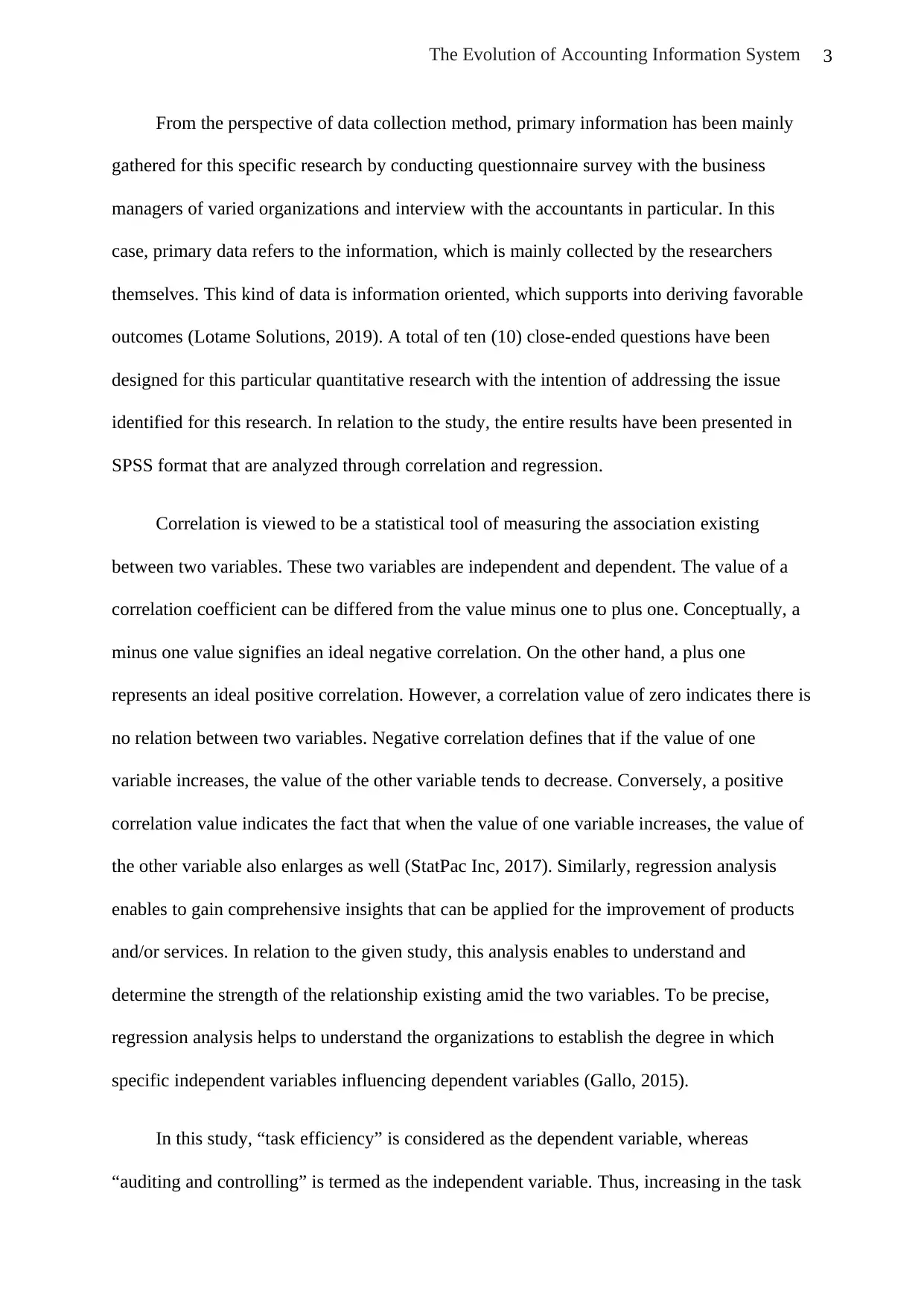
3The Evolution of Accounting Information System
From the perspective of data collection method, primary information has been mainly
gathered for this specific research by conducting questionnaire survey with the business
managers of varied organizations and interview with the accountants in particular. In this
case, primary data refers to the information, which is mainly collected by the researchers
themselves. This kind of data is information oriented, which supports into deriving favorable
outcomes (Lotame Solutions, 2019). A total of ten (10) close-ended questions have been
designed for this particular quantitative research with the intention of addressing the issue
identified for this research. In relation to the study, the entire results have been presented in
SPSS format that are analyzed through correlation and regression.
Correlation is viewed to be a statistical tool of measuring the association existing
between two variables. These two variables are independent and dependent. The value of a
correlation coefficient can be differed from the value minus one to plus one. Conceptually, a
minus one value signifies an ideal negative correlation. On the other hand, a plus one
represents an ideal positive correlation. However, a correlation value of zero indicates there is
no relation between two variables. Negative correlation defines that if the value of one
variable increases, the value of the other variable tends to decrease. Conversely, a positive
correlation value indicates the fact that when the value of one variable increases, the value of
the other variable also enlarges as well (StatPac Inc, 2017). Similarly, regression analysis
enables to gain comprehensive insights that can be applied for the improvement of products
and/or services. In relation to the given study, this analysis enables to understand and
determine the strength of the relationship existing amid the two variables. To be precise,
regression analysis helps to understand the organizations to establish the degree in which
specific independent variables influencing dependent variables (Gallo, 2015).
In this study, “task efficiency” is considered as the dependent variable, whereas
“auditing and controlling” is termed as the independent variable. Thus, increasing in the task
From the perspective of data collection method, primary information has been mainly
gathered for this specific research by conducting questionnaire survey with the business
managers of varied organizations and interview with the accountants in particular. In this
case, primary data refers to the information, which is mainly collected by the researchers
themselves. This kind of data is information oriented, which supports into deriving favorable
outcomes (Lotame Solutions, 2019). A total of ten (10) close-ended questions have been
designed for this particular quantitative research with the intention of addressing the issue
identified for this research. In relation to the study, the entire results have been presented in
SPSS format that are analyzed through correlation and regression.
Correlation is viewed to be a statistical tool of measuring the association existing
between two variables. These two variables are independent and dependent. The value of a
correlation coefficient can be differed from the value minus one to plus one. Conceptually, a
minus one value signifies an ideal negative correlation. On the other hand, a plus one
represents an ideal positive correlation. However, a correlation value of zero indicates there is
no relation between two variables. Negative correlation defines that if the value of one
variable increases, the value of the other variable tends to decrease. Conversely, a positive
correlation value indicates the fact that when the value of one variable increases, the value of
the other variable also enlarges as well (StatPac Inc, 2017). Similarly, regression analysis
enables to gain comprehensive insights that can be applied for the improvement of products
and/or services. In relation to the given study, this analysis enables to understand and
determine the strength of the relationship existing amid the two variables. To be precise,
regression analysis helps to understand the organizations to establish the degree in which
specific independent variables influencing dependent variables (Gallo, 2015).
In this study, “task efficiency” is considered as the dependent variable, whereas
“auditing and controlling” is termed as the independent variable. Thus, increasing in the task
⊘ This is a preview!⊘
Do you want full access?
Subscribe today to unlock all pages.

Trusted by 1+ million students worldwide
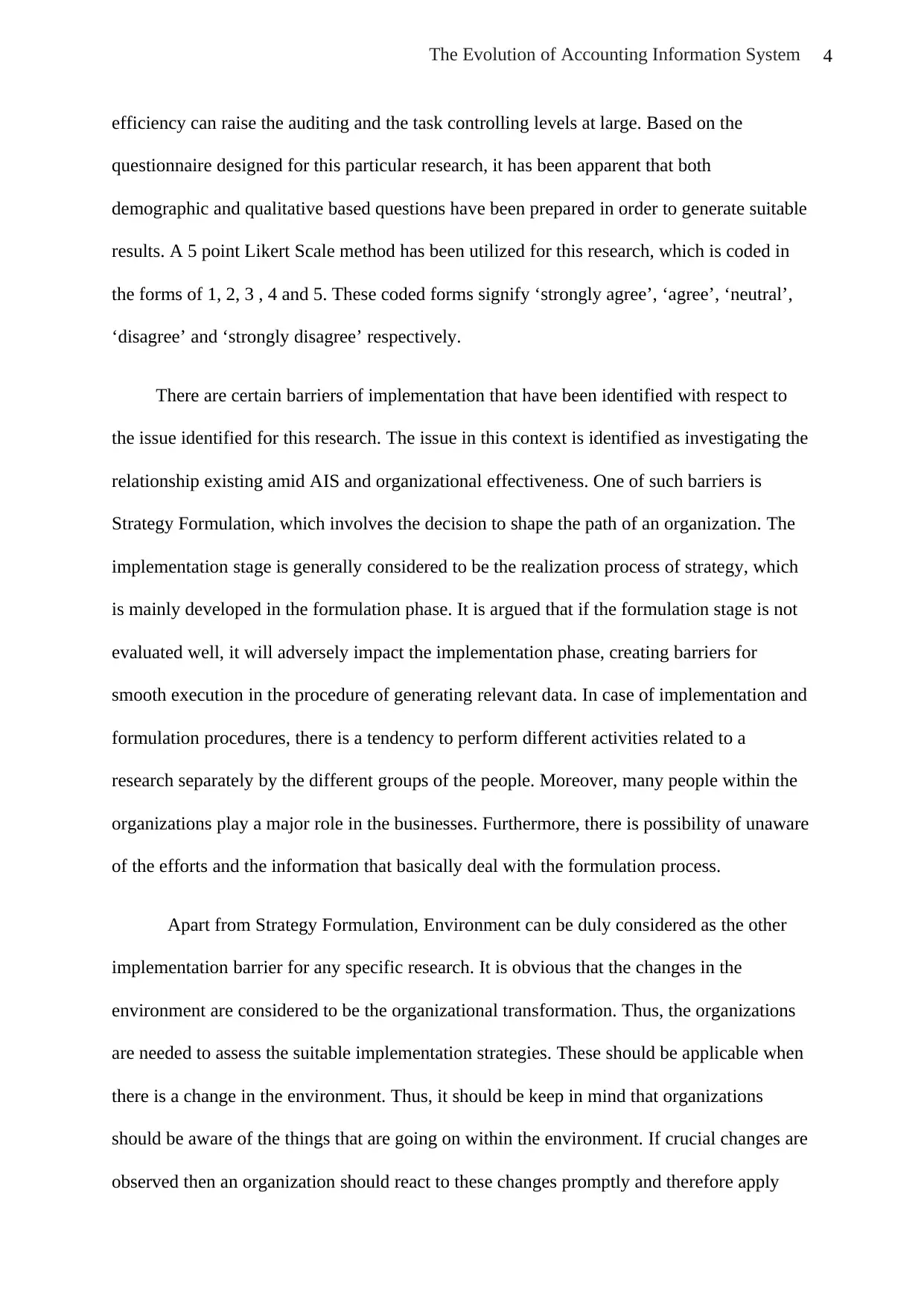
4The Evolution of Accounting Information System
efficiency can raise the auditing and the task controlling levels at large. Based on the
questionnaire designed for this particular research, it has been apparent that both
demographic and qualitative based questions have been prepared in order to generate suitable
results. A 5 point Likert Scale method has been utilized for this research, which is coded in
the forms of 1, 2, 3 , 4 and 5. These coded forms signify ‘strongly agree’, ‘agree’, ‘neutral’,
‘disagree’ and ‘strongly disagree’ respectively.
There are certain barriers of implementation that have been identified with respect to
the issue identified for this research. The issue in this context is identified as investigating the
relationship existing amid AIS and organizational effectiveness. One of such barriers is
Strategy Formulation, which involves the decision to shape the path of an organization. The
implementation stage is generally considered to be the realization process of strategy, which
is mainly developed in the formulation phase. It is argued that if the formulation stage is not
evaluated well, it will adversely impact the implementation phase, creating barriers for
smooth execution in the procedure of generating relevant data. In case of implementation and
formulation procedures, there is a tendency to perform different activities related to a
research separately by the different groups of the people. Moreover, many people within the
organizations play a major role in the businesses. Furthermore, there is possibility of unaware
of the efforts and the information that basically deal with the formulation process.
Apart from Strategy Formulation, Environment can be duly considered as the other
implementation barrier for any specific research. It is obvious that the changes in the
environment are considered to be the organizational transformation. Thus, the organizations
are needed to assess the suitable implementation strategies. These should be applicable when
there is a change in the environment. Thus, it should be keep in mind that organizations
should be aware of the things that are going on within the environment. If crucial changes are
observed then an organization should react to these changes promptly and therefore apply
efficiency can raise the auditing and the task controlling levels at large. Based on the
questionnaire designed for this particular research, it has been apparent that both
demographic and qualitative based questions have been prepared in order to generate suitable
results. A 5 point Likert Scale method has been utilized for this research, which is coded in
the forms of 1, 2, 3 , 4 and 5. These coded forms signify ‘strongly agree’, ‘agree’, ‘neutral’,
‘disagree’ and ‘strongly disagree’ respectively.
There are certain barriers of implementation that have been identified with respect to
the issue identified for this research. The issue in this context is identified as investigating the
relationship existing amid AIS and organizational effectiveness. One of such barriers is
Strategy Formulation, which involves the decision to shape the path of an organization. The
implementation stage is generally considered to be the realization process of strategy, which
is mainly developed in the formulation phase. It is argued that if the formulation stage is not
evaluated well, it will adversely impact the implementation phase, creating barriers for
smooth execution in the procedure of generating relevant data. In case of implementation and
formulation procedures, there is a tendency to perform different activities related to a
research separately by the different groups of the people. Moreover, many people within the
organizations play a major role in the businesses. Furthermore, there is possibility of unaware
of the efforts and the information that basically deal with the formulation process.
Apart from Strategy Formulation, Environment can be duly considered as the other
implementation barrier for any specific research. It is obvious that the changes in the
environment are considered to be the organizational transformation. Thus, the organizations
are needed to assess the suitable implementation strategies. These should be applicable when
there is a change in the environment. Thus, it should be keep in mind that organizations
should be aware of the things that are going on within the environment. If crucial changes are
observed then an organization should react to these changes promptly and therefore apply
Paraphrase This Document
Need a fresh take? Get an instant paraphrase of this document with our AI Paraphraser
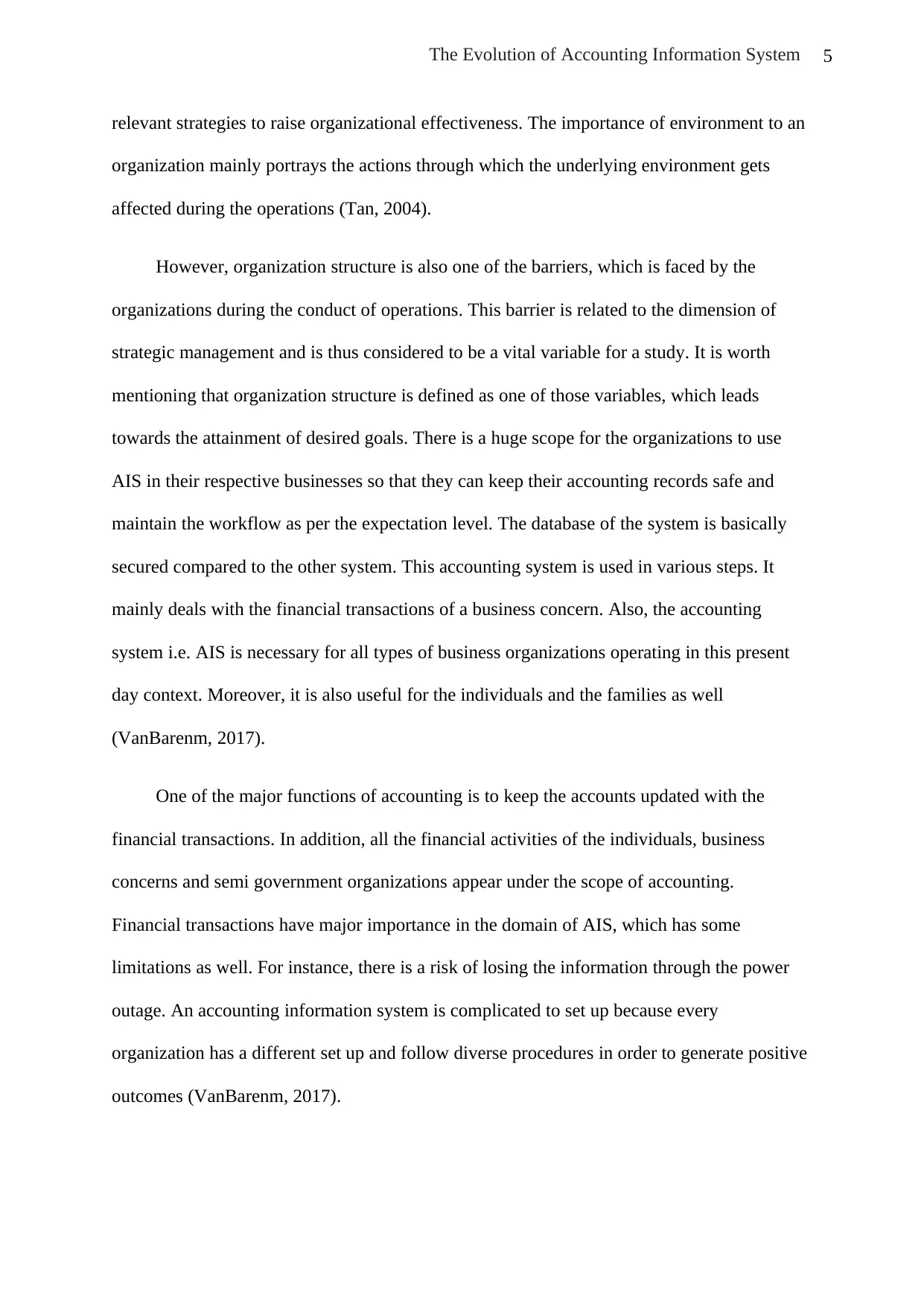
5The Evolution of Accounting Information System
relevant strategies to raise organizational effectiveness. The importance of environment to an
organization mainly portrays the actions through which the underlying environment gets
affected during the operations (Tan, 2004).
However, organization structure is also one of the barriers, which is faced by the
organizations during the conduct of operations. This barrier is related to the dimension of
strategic management and is thus considered to be a vital variable for a study. It is worth
mentioning that organization structure is defined as one of those variables, which leads
towards the attainment of desired goals. There is a huge scope for the organizations to use
AIS in their respective businesses so that they can keep their accounting records safe and
maintain the workflow as per the expectation level. The database of the system is basically
secured compared to the other system. This accounting system is used in various steps. It
mainly deals with the financial transactions of a business concern. Also, the accounting
system i.e. AIS is necessary for all types of business organizations operating in this present
day context. Moreover, it is also useful for the individuals and the families as well
(VanBarenm, 2017).
One of the major functions of accounting is to keep the accounts updated with the
financial transactions. In addition, all the financial activities of the individuals, business
concerns and semi government organizations appear under the scope of accounting.
Financial transactions have major importance in the domain of AIS, which has some
limitations as well. For instance, there is a risk of losing the information through the power
outage. An accounting information system is complicated to set up because every
organization has a different set up and follow diverse procedures in order to generate positive
outcomes (VanBarenm, 2017).
relevant strategies to raise organizational effectiveness. The importance of environment to an
organization mainly portrays the actions through which the underlying environment gets
affected during the operations (Tan, 2004).
However, organization structure is also one of the barriers, which is faced by the
organizations during the conduct of operations. This barrier is related to the dimension of
strategic management and is thus considered to be a vital variable for a study. It is worth
mentioning that organization structure is defined as one of those variables, which leads
towards the attainment of desired goals. There is a huge scope for the organizations to use
AIS in their respective businesses so that they can keep their accounting records safe and
maintain the workflow as per the expectation level. The database of the system is basically
secured compared to the other system. This accounting system is used in various steps. It
mainly deals with the financial transactions of a business concern. Also, the accounting
system i.e. AIS is necessary for all types of business organizations operating in this present
day context. Moreover, it is also useful for the individuals and the families as well
(VanBarenm, 2017).
One of the major functions of accounting is to keep the accounts updated with the
financial transactions. In addition, all the financial activities of the individuals, business
concerns and semi government organizations appear under the scope of accounting.
Financial transactions have major importance in the domain of AIS, which has some
limitations as well. For instance, there is a risk of losing the information through the power
outage. An accounting information system is complicated to set up because every
organization has a different set up and follow diverse procedures in order to generate positive
outcomes (VanBarenm, 2017).
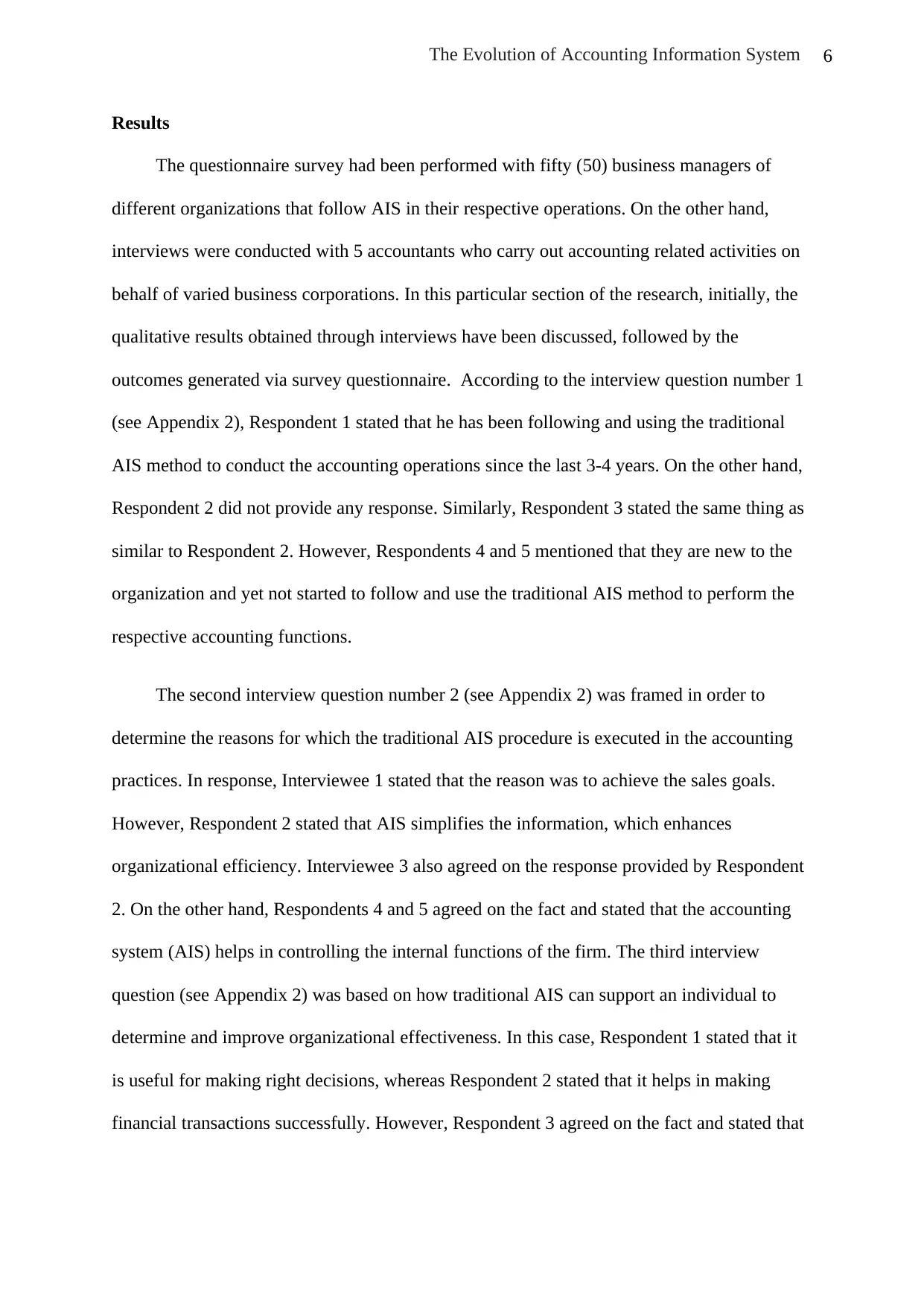
6The Evolution of Accounting Information System
Results
The questionnaire survey had been performed with fifty (50) business managers of
different organizations that follow AIS in their respective operations. On the other hand,
interviews were conducted with 5 accountants who carry out accounting related activities on
behalf of varied business corporations. In this particular section of the research, initially, the
qualitative results obtained through interviews have been discussed, followed by the
outcomes generated via survey questionnaire. According to the interview question number 1
(see Appendix 2), Respondent 1 stated that he has been following and using the traditional
AIS method to conduct the accounting operations since the last 3-4 years. On the other hand,
Respondent 2 did not provide any response. Similarly, Respondent 3 stated the same thing as
similar to Respondent 2. However, Respondents 4 and 5 mentioned that they are new to the
organization and yet not started to follow and use the traditional AIS method to perform the
respective accounting functions.
The second interview question number 2 (see Appendix 2) was framed in order to
determine the reasons for which the traditional AIS procedure is executed in the accounting
practices. In response, Interviewee 1 stated that the reason was to achieve the sales goals.
However, Respondent 2 stated that AIS simplifies the information, which enhances
organizational efficiency. Interviewee 3 also agreed on the response provided by Respondent
2. On the other hand, Respondents 4 and 5 agreed on the fact and stated that the accounting
system (AIS) helps in controlling the internal functions of the firm. The third interview
question (see Appendix 2) was based on how traditional AIS can support an individual to
determine and improve organizational effectiveness. In this case, Respondent 1 stated that it
is useful for making right decisions, whereas Respondent 2 stated that it helps in making
financial transactions successfully. However, Respondent 3 agreed on the fact and stated that
Results
The questionnaire survey had been performed with fifty (50) business managers of
different organizations that follow AIS in their respective operations. On the other hand,
interviews were conducted with 5 accountants who carry out accounting related activities on
behalf of varied business corporations. In this particular section of the research, initially, the
qualitative results obtained through interviews have been discussed, followed by the
outcomes generated via survey questionnaire. According to the interview question number 1
(see Appendix 2), Respondent 1 stated that he has been following and using the traditional
AIS method to conduct the accounting operations since the last 3-4 years. On the other hand,
Respondent 2 did not provide any response. Similarly, Respondent 3 stated the same thing as
similar to Respondent 2. However, Respondents 4 and 5 mentioned that they are new to the
organization and yet not started to follow and use the traditional AIS method to perform the
respective accounting functions.
The second interview question number 2 (see Appendix 2) was framed in order to
determine the reasons for which the traditional AIS procedure is executed in the accounting
practices. In response, Interviewee 1 stated that the reason was to achieve the sales goals.
However, Respondent 2 stated that AIS simplifies the information, which enhances
organizational efficiency. Interviewee 3 also agreed on the response provided by Respondent
2. On the other hand, Respondents 4 and 5 agreed on the fact and stated that the accounting
system (AIS) helps in controlling the internal functions of the firm. The third interview
question (see Appendix 2) was based on how traditional AIS can support an individual to
determine and improve organizational effectiveness. In this case, Respondent 1 stated that it
is useful for making right decisions, whereas Respondent 2 stated that it helps in making
financial transactions successfully. However, Respondent 3 agreed on the fact and stated that
⊘ This is a preview!⊘
Do you want full access?
Subscribe today to unlock all pages.

Trusted by 1+ million students worldwide
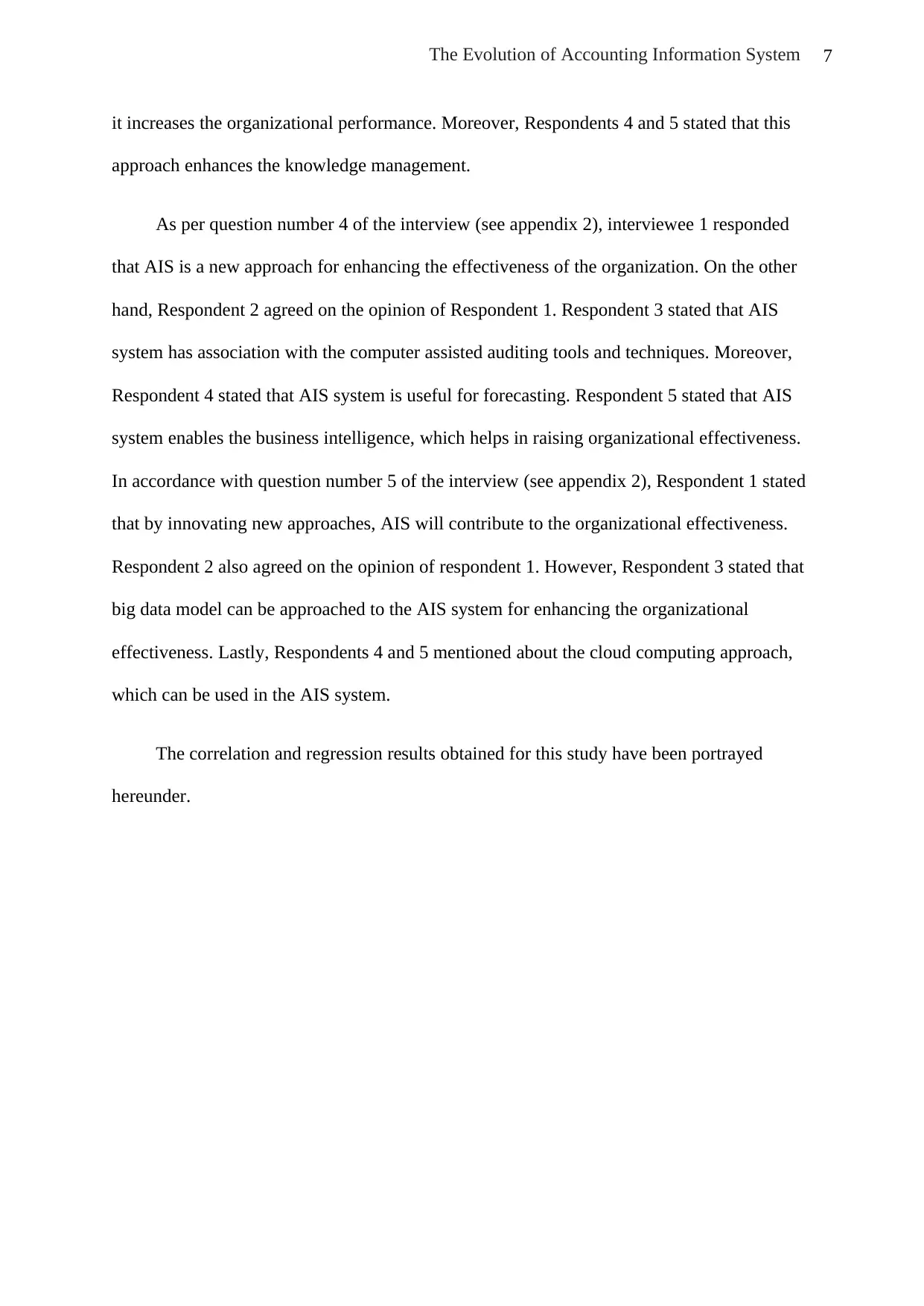
7The Evolution of Accounting Information System
it increases the organizational performance. Moreover, Respondents 4 and 5 stated that this
approach enhances the knowledge management.
As per question number 4 of the interview (see appendix 2), interviewee 1 responded
that AIS is a new approach for enhancing the effectiveness of the organization. On the other
hand, Respondent 2 agreed on the opinion of Respondent 1. Respondent 3 stated that AIS
system has association with the computer assisted auditing tools and techniques. Moreover,
Respondent 4 stated that AIS system is useful for forecasting. Respondent 5 stated that AIS
system enables the business intelligence, which helps in raising organizational effectiveness.
In accordance with question number 5 of the interview (see appendix 2), Respondent 1 stated
that by innovating new approaches, AIS will contribute to the organizational effectiveness.
Respondent 2 also agreed on the opinion of respondent 1. However, Respondent 3 stated that
big data model can be approached to the AIS system for enhancing the organizational
effectiveness. Lastly, Respondents 4 and 5 mentioned about the cloud computing approach,
which can be used in the AIS system.
The correlation and regression results obtained for this study have been portrayed
hereunder.
it increases the organizational performance. Moreover, Respondents 4 and 5 stated that this
approach enhances the knowledge management.
As per question number 4 of the interview (see appendix 2), interviewee 1 responded
that AIS is a new approach for enhancing the effectiveness of the organization. On the other
hand, Respondent 2 agreed on the opinion of Respondent 1. Respondent 3 stated that AIS
system has association with the computer assisted auditing tools and techniques. Moreover,
Respondent 4 stated that AIS system is useful for forecasting. Respondent 5 stated that AIS
system enables the business intelligence, which helps in raising organizational effectiveness.
In accordance with question number 5 of the interview (see appendix 2), Respondent 1 stated
that by innovating new approaches, AIS will contribute to the organizational effectiveness.
Respondent 2 also agreed on the opinion of respondent 1. However, Respondent 3 stated that
big data model can be approached to the AIS system for enhancing the organizational
effectiveness. Lastly, Respondents 4 and 5 mentioned about the cloud computing approach,
which can be used in the AIS system.
The correlation and regression results obtained for this study have been portrayed
hereunder.
Paraphrase This Document
Need a fresh take? Get an instant paraphrase of this document with our AI Paraphraser
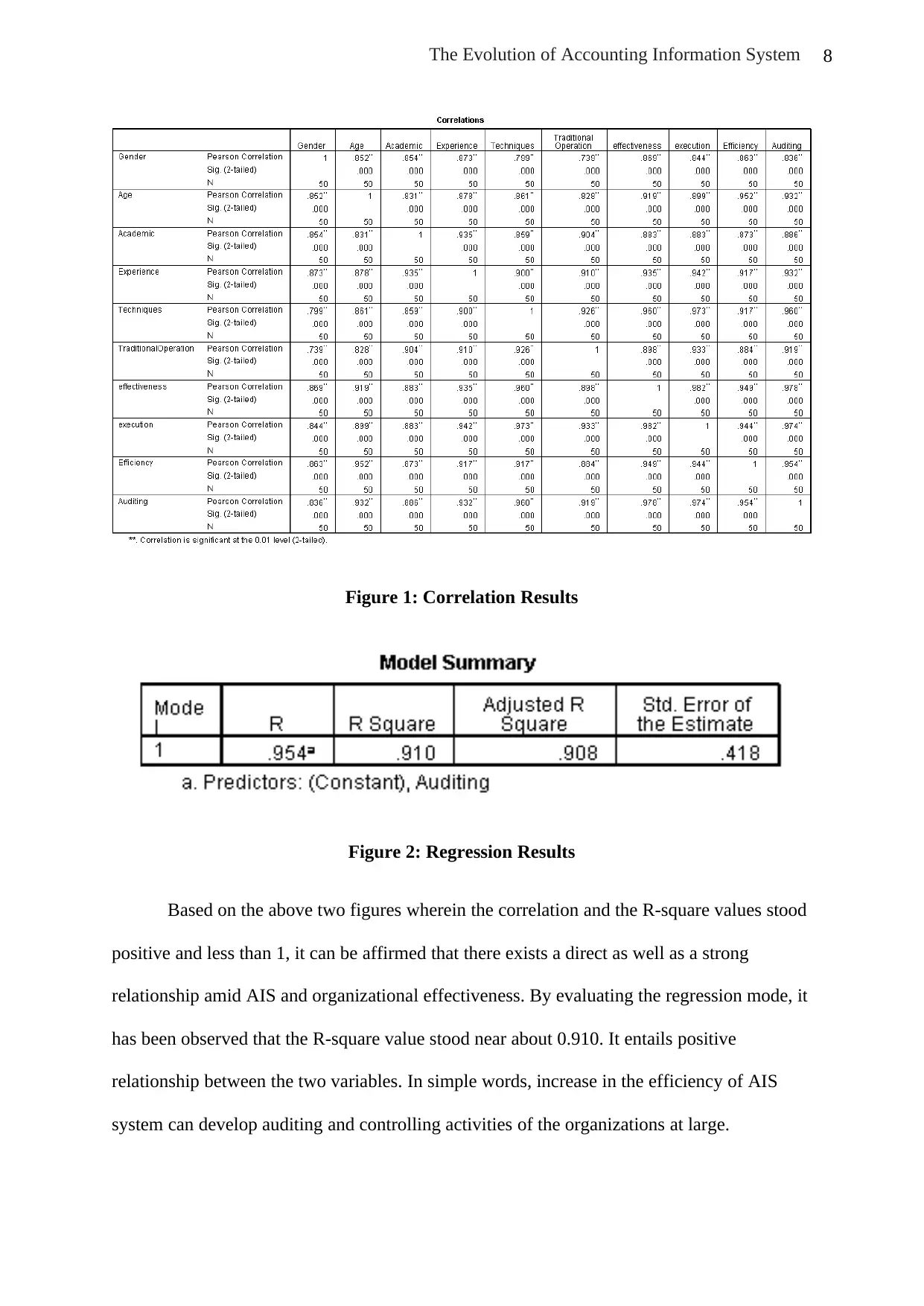
8The Evolution of Accounting Information System
Figure 1: Correlation Results
Figure 2: Regression Results
Based on the above two figures wherein the correlation and the R-square values stood
positive and less than 1, it can be affirmed that there exists a direct as well as a strong
relationship amid AIS and organizational effectiveness. By evaluating the regression mode, it
has been observed that the R-square value stood near about 0.910. It entails positive
relationship between the two variables. In simple words, increase in the efficiency of AIS
system can develop auditing and controlling activities of the organizations at large.
Figure 1: Correlation Results
Figure 2: Regression Results
Based on the above two figures wherein the correlation and the R-square values stood
positive and less than 1, it can be affirmed that there exists a direct as well as a strong
relationship amid AIS and organizational effectiveness. By evaluating the regression mode, it
has been observed that the R-square value stood near about 0.910. It entails positive
relationship between the two variables. In simple words, increase in the efficiency of AIS
system can develop auditing and controlling activities of the organizations at large.
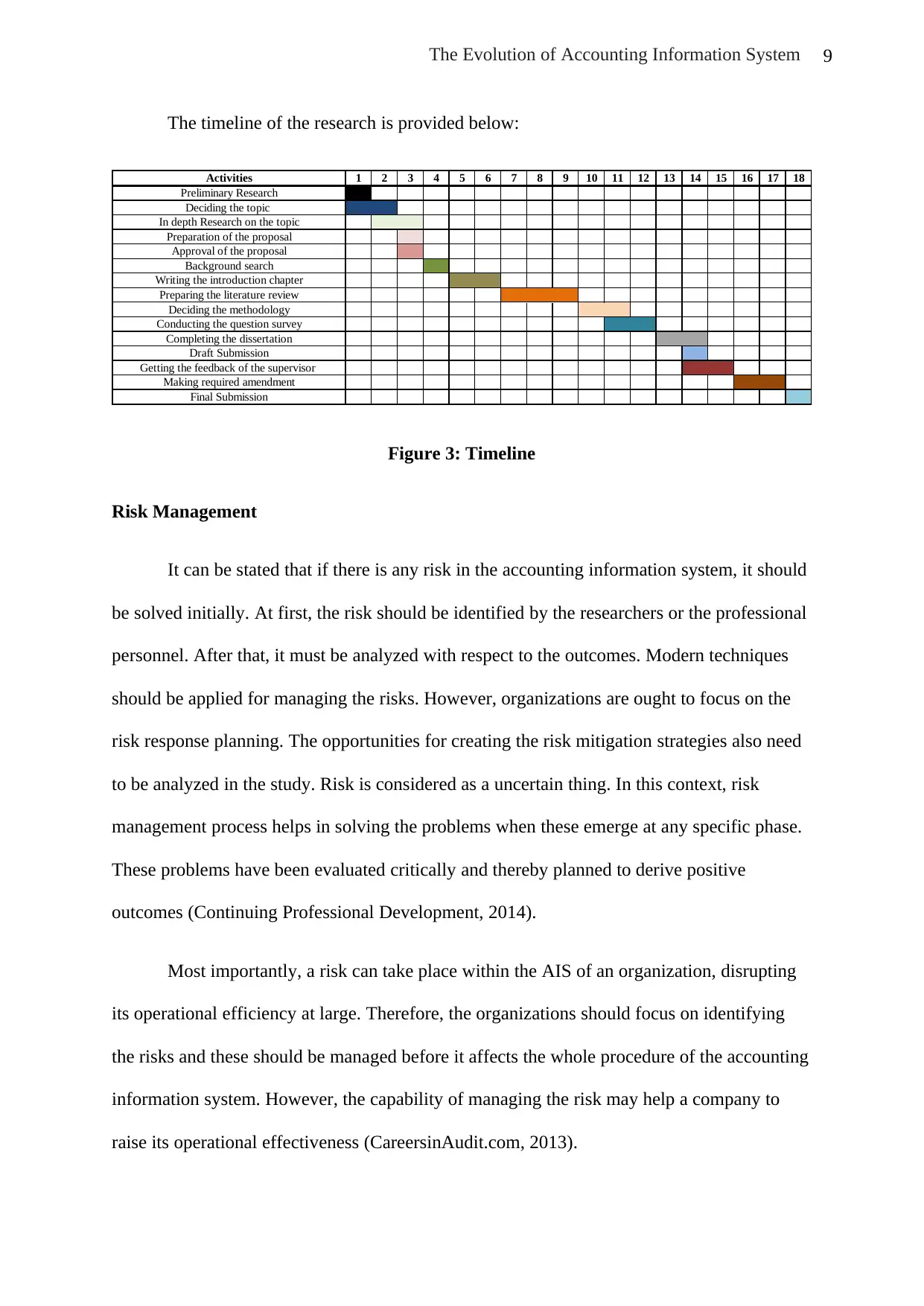
9The Evolution of Accounting Information System
The timeline of the research is provided below:
Activities 1 2 3 4 5 6 7 8 9 10 11 12 13 14 15 16 17 18
Preliminary Research
Deciding the topic
In depth Research on the topic
Preparation of the proposal
Approval of the proposal
Background search
Writing the introduction chapter
Preparing the literature review
Deciding the methodology
Conducting the question survey
Completing the dissertation
Draft Submission
Getting the feedback of the supervisor
Making required amendment
Final Submission
Figure 3: Timeline
Risk Management
It can be stated that if there is any risk in the accounting information system, it should
be solved initially. At first, the risk should be identified by the researchers or the professional
personnel. After that, it must be analyzed with respect to the outcomes. Modern techniques
should be applied for managing the risks. However, organizations are ought to focus on the
risk response planning. The opportunities for creating the risk mitigation strategies also need
to be analyzed in the study. Risk is considered as a uncertain thing. In this context, risk
management process helps in solving the problems when these emerge at any specific phase.
These problems have been evaluated critically and thereby planned to derive positive
outcomes (Continuing Professional Development, 2014).
Most importantly, a risk can take place within the AIS of an organization, disrupting
its operational efficiency at large. Therefore, the organizations should focus on identifying
the risks and these should be managed before it affects the whole procedure of the accounting
information system. However, the capability of managing the risk may help a company to
raise its operational effectiveness (CareersinAudit.com, 2013).
The timeline of the research is provided below:
Activities 1 2 3 4 5 6 7 8 9 10 11 12 13 14 15 16 17 18
Preliminary Research
Deciding the topic
In depth Research on the topic
Preparation of the proposal
Approval of the proposal
Background search
Writing the introduction chapter
Preparing the literature review
Deciding the methodology
Conducting the question survey
Completing the dissertation
Draft Submission
Getting the feedback of the supervisor
Making required amendment
Final Submission
Figure 3: Timeline
Risk Management
It can be stated that if there is any risk in the accounting information system, it should
be solved initially. At first, the risk should be identified by the researchers or the professional
personnel. After that, it must be analyzed with respect to the outcomes. Modern techniques
should be applied for managing the risks. However, organizations are ought to focus on the
risk response planning. The opportunities for creating the risk mitigation strategies also need
to be analyzed in the study. Risk is considered as a uncertain thing. In this context, risk
management process helps in solving the problems when these emerge at any specific phase.
These problems have been evaluated critically and thereby planned to derive positive
outcomes (Continuing Professional Development, 2014).
Most importantly, a risk can take place within the AIS of an organization, disrupting
its operational efficiency at large. Therefore, the organizations should focus on identifying
the risks and these should be managed before it affects the whole procedure of the accounting
information system. However, the capability of managing the risk may help a company to
raise its operational effectiveness (CareersinAudit.com, 2013).
⊘ This is a preview!⊘
Do you want full access?
Subscribe today to unlock all pages.

Trusted by 1+ million students worldwide
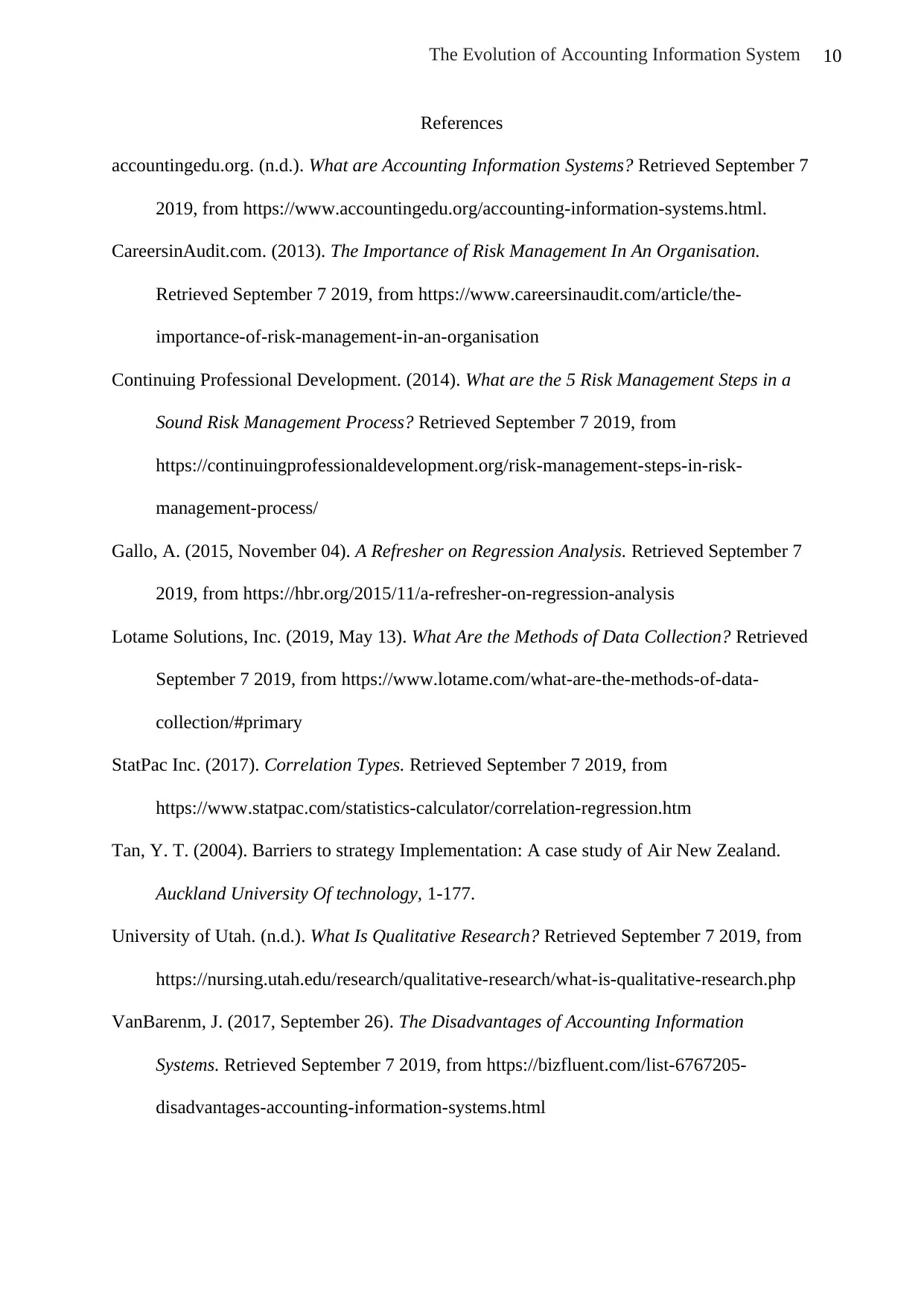
10The Evolution of Accounting Information System
References
accountingedu.org. (n.d.). What are Accounting Information Systems? Retrieved September 7
2019, from https://www.accountingedu.org/accounting-information-systems.html.
CareersinAudit.com. (2013). The Importance of Risk Management In An Organisation.
Retrieved September 7 2019, from https://www.careersinaudit.com/article/the-
importance-of-risk-management-in-an-organisation
Continuing Professional Development. (2014). What are the 5 Risk Management Steps in a
Sound Risk Management Process? Retrieved September 7 2019, from
https://continuingprofessionaldevelopment.org/risk-management-steps-in-risk-
management-process/
Gallo, A. (2015, November 04). A Refresher on Regression Analysis. Retrieved September 7
2019, from https://hbr.org/2015/11/a-refresher-on-regression-analysis
Lotame Solutions, Inc. (2019, May 13). What Are the Methods of Data Collection? Retrieved
September 7 2019, from https://www.lotame.com/what-are-the-methods-of-data-
collection/#primary
StatPac Inc. (2017). Correlation Types. Retrieved September 7 2019, from
https://www.statpac.com/statistics-calculator/correlation-regression.htm
Tan, Y. T. (2004). Barriers to strategy Implementation: A case study of Air New Zealand.
Auckland University Of technology, 1-177.
University of Utah. (n.d.). What Is Qualitative Research? Retrieved September 7 2019, from
https://nursing.utah.edu/research/qualitative-research/what-is-qualitative-research.php
VanBarenm, J. (2017, September 26). The Disadvantages of Accounting Information
Systems. Retrieved September 7 2019, from https://bizfluent.com/list-6767205-
disadvantages-accounting-information-systems.html
References
accountingedu.org. (n.d.). What are Accounting Information Systems? Retrieved September 7
2019, from https://www.accountingedu.org/accounting-information-systems.html.
CareersinAudit.com. (2013). The Importance of Risk Management In An Organisation.
Retrieved September 7 2019, from https://www.careersinaudit.com/article/the-
importance-of-risk-management-in-an-organisation
Continuing Professional Development. (2014). What are the 5 Risk Management Steps in a
Sound Risk Management Process? Retrieved September 7 2019, from
https://continuingprofessionaldevelopment.org/risk-management-steps-in-risk-
management-process/
Gallo, A. (2015, November 04). A Refresher on Regression Analysis. Retrieved September 7
2019, from https://hbr.org/2015/11/a-refresher-on-regression-analysis
Lotame Solutions, Inc. (2019, May 13). What Are the Methods of Data Collection? Retrieved
September 7 2019, from https://www.lotame.com/what-are-the-methods-of-data-
collection/#primary
StatPac Inc. (2017). Correlation Types. Retrieved September 7 2019, from
https://www.statpac.com/statistics-calculator/correlation-regression.htm
Tan, Y. T. (2004). Barriers to strategy Implementation: A case study of Air New Zealand.
Auckland University Of technology, 1-177.
University of Utah. (n.d.). What Is Qualitative Research? Retrieved September 7 2019, from
https://nursing.utah.edu/research/qualitative-research/what-is-qualitative-research.php
VanBarenm, J. (2017, September 26). The Disadvantages of Accounting Information
Systems. Retrieved September 7 2019, from https://bizfluent.com/list-6767205-
disadvantages-accounting-information-systems.html
Paraphrase This Document
Need a fresh take? Get an instant paraphrase of this document with our AI Paraphraser
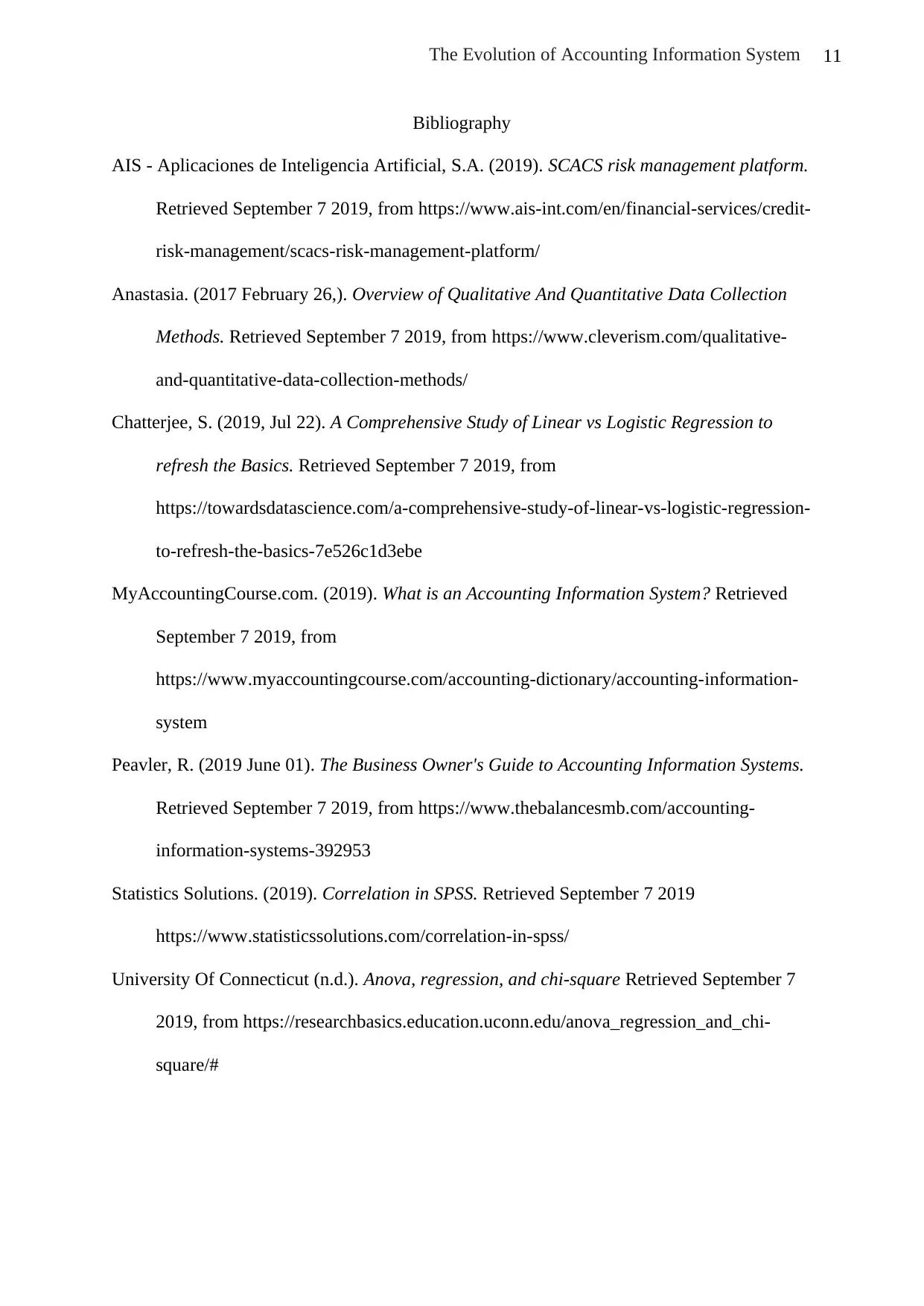
11The Evolution of Accounting Information System
Bibliography
AIS - Aplicaciones de Inteligencia Artificial, S.A. (2019). SCACS risk management platform.
Retrieved September 7 2019, from https://www.ais-int.com/en/financial-services/credit-
risk-management/scacs-risk-management-platform/
Anastasia. (2017 February 26,). Overview of Qualitative And Quantitative Data Collection
Methods. Retrieved September 7 2019, from https://www.cleverism.com/qualitative-
and-quantitative-data-collection-methods/
Chatterjee, S. (2019, Jul 22). A Comprehensive Study of Linear vs Logistic Regression to
refresh the Basics. Retrieved September 7 2019, from
https://towardsdatascience.com/a-comprehensive-study-of-linear-vs-logistic-regression-
to-refresh-the-basics-7e526c1d3ebe
MyAccountingCourse.com. (2019). What is an Accounting Information System? Retrieved
September 7 2019, from
https://www.myaccountingcourse.com/accounting-dictionary/accounting-information-
system
Peavler, R. (2019 June 01). The Business Owner's Guide to Accounting Information Systems.
Retrieved September 7 2019, from https://www.thebalancesmb.com/accounting-
information-systems-392953
Statistics Solutions. (2019). Correlation in SPSS. Retrieved September 7 2019
https://www.statisticssolutions.com/correlation-in-spss/
University Of Connecticut (n.d.). Anova, regression, and chi-square Retrieved September 7
2019, from https://researchbasics.education.uconn.edu/anova_regression_and_chi-
square/#
Bibliography
AIS - Aplicaciones de Inteligencia Artificial, S.A. (2019). SCACS risk management platform.
Retrieved September 7 2019, from https://www.ais-int.com/en/financial-services/credit-
risk-management/scacs-risk-management-platform/
Anastasia. (2017 February 26,). Overview of Qualitative And Quantitative Data Collection
Methods. Retrieved September 7 2019, from https://www.cleverism.com/qualitative-
and-quantitative-data-collection-methods/
Chatterjee, S. (2019, Jul 22). A Comprehensive Study of Linear vs Logistic Regression to
refresh the Basics. Retrieved September 7 2019, from
https://towardsdatascience.com/a-comprehensive-study-of-linear-vs-logistic-regression-
to-refresh-the-basics-7e526c1d3ebe
MyAccountingCourse.com. (2019). What is an Accounting Information System? Retrieved
September 7 2019, from
https://www.myaccountingcourse.com/accounting-dictionary/accounting-information-
system
Peavler, R. (2019 June 01). The Business Owner's Guide to Accounting Information Systems.
Retrieved September 7 2019, from https://www.thebalancesmb.com/accounting-
information-systems-392953
Statistics Solutions. (2019). Correlation in SPSS. Retrieved September 7 2019
https://www.statisticssolutions.com/correlation-in-spss/
University Of Connecticut (n.d.). Anova, regression, and chi-square Retrieved September 7
2019, from https://researchbasics.education.uconn.edu/anova_regression_and_chi-
square/#
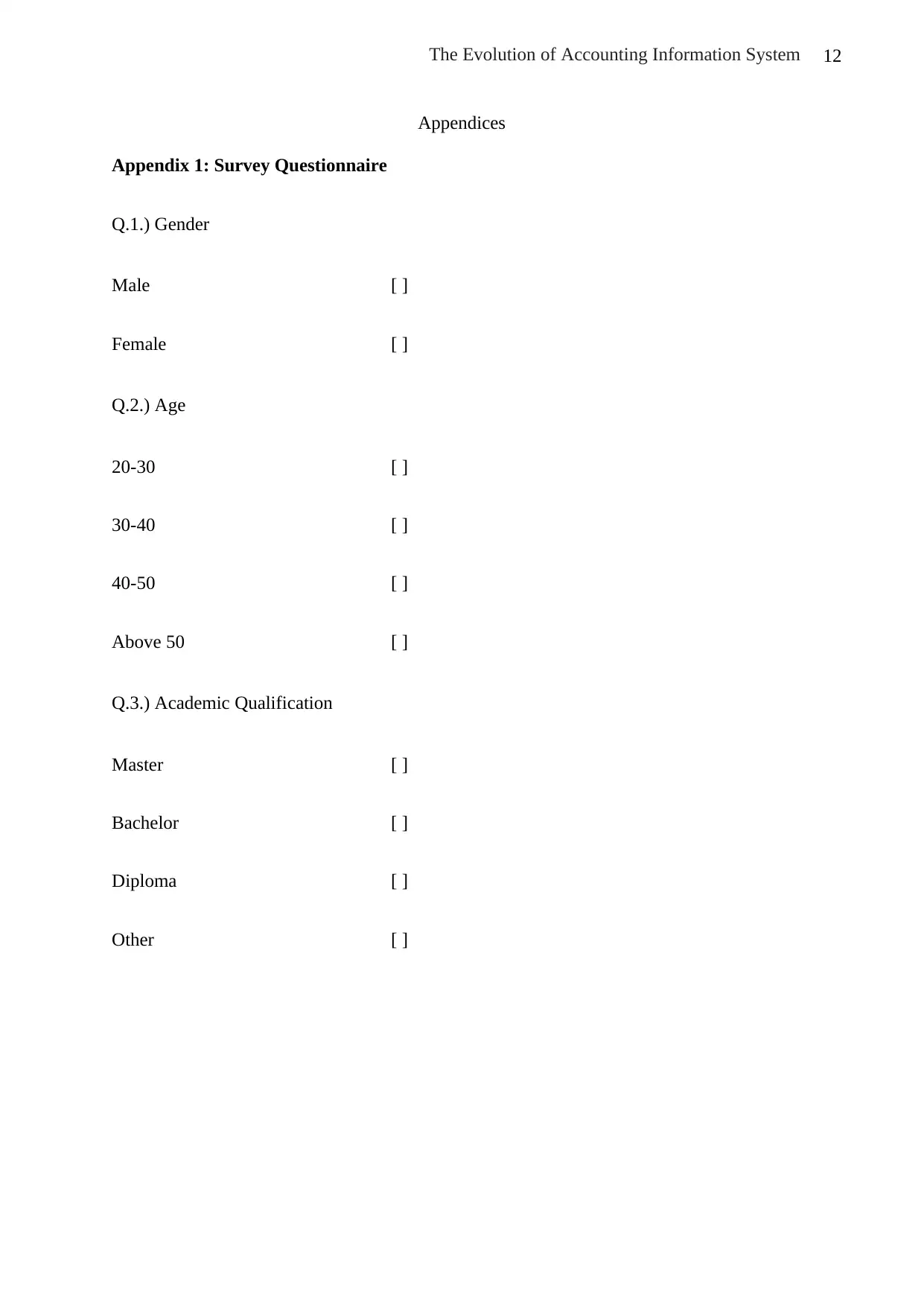
12The Evolution of Accounting Information System
Appendices
Appendix 1: Survey Questionnaire
Q.1.) Gender
Male [ ]
Female [ ]
Q.2.) Age
20-30 [ ]
30-40 [ ]
40-50 [ ]
Above 50 [ ]
Q.3.) Academic Qualification
Master [ ]
Bachelor [ ]
Diploma [ ]
Other [ ]
Appendices
Appendix 1: Survey Questionnaire
Q.1.) Gender
Male [ ]
Female [ ]
Q.2.) Age
20-30 [ ]
30-40 [ ]
40-50 [ ]
Above 50 [ ]
Q.3.) Academic Qualification
Master [ ]
Bachelor [ ]
Diploma [ ]
Other [ ]
⊘ This is a preview!⊘
Do you want full access?
Subscribe today to unlock all pages.

Trusted by 1+ million students worldwide
1 out of 16
Related Documents
Your All-in-One AI-Powered Toolkit for Academic Success.
+13062052269
info@desklib.com
Available 24*7 on WhatsApp / Email
![[object Object]](/_next/static/media/star-bottom.7253800d.svg)
Unlock your academic potential
Copyright © 2020–2025 A2Z Services. All Rights Reserved. Developed and managed by ZUCOL.





